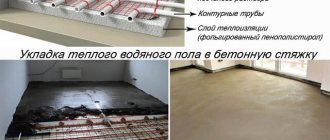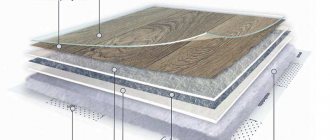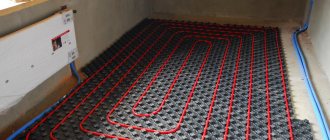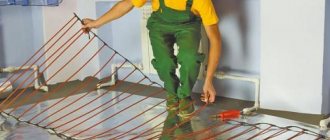How to improve the comfort of the bedroom?
To arrange a bedroom in a home, non-passage rooms are most often used, where it will be convenient to relax after a working day. The interior design concept uses soft and muted tones, pleasant-to-touch textures of finishing and decorative materials, and subdued lighting systems.
And, although experts recommend sleeping in a cool room, it is in this room that you want to maintain a certain temperature regime. You can heat the room through the operation of a centralized or individual heating system, but you can use other options.
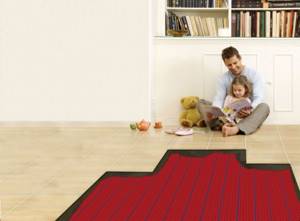
Installing heating devices can reduce the harmony of the interior and individual devices can take up a lot of free space. An interesting and original solution would be to install a heated floor, a low-temperature system that will help achieve the desired temperature and maintain a cozy atmosphere.
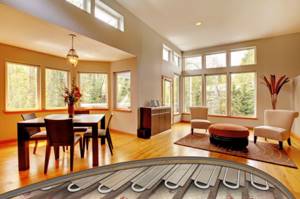
Video text
A gift from our channel: a large (156 pages) guide to underfloor heating. https://teploclub.com/blog/Podpiska/Al.
Many people deliberately deprive themselves of the pleasure of having TP in the bedroom. Usually the argument is that somewhere it is written that you need to sleep in a cool room, otherwise you will get a headache, and that thermal radiation has a bad effect on your head and overall well-being, and a warm floor cannot provide the desired comfortable climate in the bedroom. I will now give all the arguments for warm floors in the bedroom that I can remember. You can add in the comments what I missed. Or, on the contrary, give killer counterarguments that will convince me to abandon such an idea. And so, first, about the advantages in general. 1. Warm floors are more economical than radiator heating. 2. Warm floors allow you to maintain a stable temperature with minimal fluctuations. 3. If an accident occurs, the cement screed retains heat for a long time. 4. The screed can accumulate heat from solid fuel boilers, as an alternative to water heat accumulators. 5. It's easier to make any design decisions because the batteries don't get in the way. 6. It is easier to clean the floor if radiator pipes do not stick out from the floor. 7. Heated floors can be easily installed even by a beginner. 8. Warm floors are durable and reliable. 9. Installation of light heated floors is now available. 10. For me, warm is better than cold. 11. More arguments “For”. • Russian stove. • Chambers. • High bed legs. • Heated hydro mattresses. • Korean tradition of heated floors and baths. 12. Thermal radiation from the floor is perfectly shielded by the mattress and pillow. 13. There are no regulatory restrictions on the use of heated floors in sleeping areas, including in kindergartens and nurseries. 14. We can set the temperature we need • Room thermostat and servos on the manifold. • Any desired temperature at any specific time. • You can place the thermostat at bed level. • One or two branches can be adjusted separately to the desired result. True, depending on the weather, you will have to reconfigure. Use a good finish, not cheap laminate or linoleum.
I will send you SNiP, where in paragraph 3.16 there is a table of permissible temperatures for the surface of structures with built-in heating elements. Including for TP. I will also send my subscribers a link to my video about a light heated floor, when you have wooden floors and you cannot pour a cement screed on a water heated floor. And a couple of links to the websites of manufacturers of plates and mats for light heated floors.
Many people have difficulties when it comes to selecting the installation step of the heating system and the temperature of the coolant if they know what kind of finished floor covering you will have and what heat loss this water-heated floor should provide. At the same time, you also need to not go beyond the temperature recommended by SNIP. And I will send you this table. I have already sent it to my subscribers, and who else, by some absurd accident, is not my subscriber, follow the link, subscribe and receive it right in a couple of minutes.
Friends, I hope I convinced you to lay warm floors in your bedroom. Do not deny yourself comfort and do not take false fears for granted.
Share with your friends. This is the best thank you for my time. I still have a lot to tell you. Sign up for the VKontakte group and the mailing list of my educational materials. Sergey Volkov.
Basic flooring methods
When understanding the question of whether a warm floor is needed in the bedroom, it would be useful to study information and the method of installing a floor heating system. After all, if you need to carry out quite labor-intensive work with a high level of costs, you can safely abandon this idea, and use a non-standard solution at moderate costs.
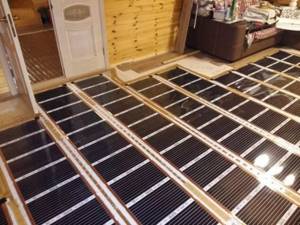
Manufacturers offer different systems that can be installed in different ways, but the most common installation methods remain the following:
- concrete screed;
- wooden floor;
- Self-leveling floors.

Modern methods of installing floor heating systems, which are special fasteners, deserve special attention. The fastening elements are placed on a strong and wear-resistant fabric, the reverse surface of such material is covered with a heat-insulating layer.
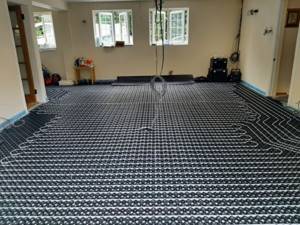
By fixing heating cables or flexible pipes with coolant, you can avoid using a concrete screed or lumber, which will significantly reduce the cost of installing the system.
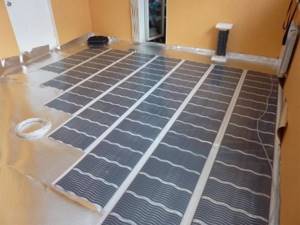
Laying IR film
Comparing different systems according to the installation method, we can highlight the infrared film used to heat the floor covering. The film is installed even without dismantling the base materials, provides excellent heating, and one of its sides already has thermal insulation characteristics.

This modern solution helps distribute heat to the necessary areas of the room and reduce installation costs, without the use of a concrete screed or additional base.
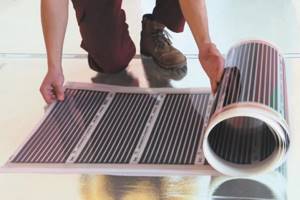
Uniform air heating
Warm floors, unlike radiators, heat the room evenly. The entire open surface of the floor radiates heat. The air at floor level warms up as much as possible and above that the temperature gradually decreases. This distribution of heat in a room is most comfortable for a person.

The radiator is often located in the coldest point of the room - under the window. To heat the entire room, the water in it must be very hot, up to 90 degrees. Therefore, it is hot in the space near the radiator, and the far corners of the room do not warm up enough.

Geometry of equipment laying
Experienced builders offer several simple options for laying infrastructure and elements of a floor heating system. The choice of geometric shape determines how effective the heating of the floor covering will be and what level of comfort can be achieved in an isolated room:
- spiral laying;
- parallel type;
- sequential installation.

An interesting solution could be to lay the necessary heating elements not along the entire perimeter of the floor in the bedroom. The mobility and lightness of the design allows the elements of the system to be laid in areas where it is most necessary to warm the floor, for example, next to the sleeping area, near an armchair or wardrobe.
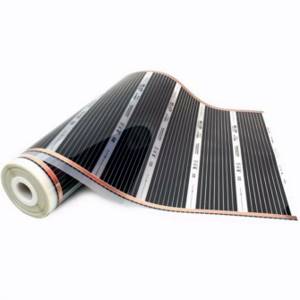
Comfortable air temperature
- The floor temperature in residential premises where people are constantly occupied is 24-26 degrees. At a height of 0.5 to 1 m from the floor, the temperature is approximately 2 degrees lower.
- The bed is located exactly at this height.
- The permissible temperature for a bedroom according to GOST for a bedroom in winter is 18-24 degrees. But it is important to focus on individual preferences.

If there is an automatic thermostat, the temperature is regulated. In the bedroom you can set day or night mode.
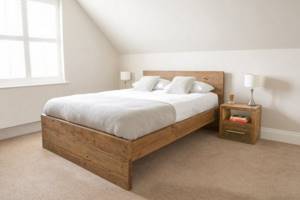
For example, at night you can lower the heating temperature by a few degrees. The air in the room will become cooler. At the same time, the floor will maintain a comfortable temperature.

Advantages and disadvantages of heated floors
Having studied each existing plus and minus of heated floors in the bedroom, you can make a choice in favor of installing the system or abandon this idea. Such a balanced approach will help optimize the costs of furnishing your own home in compliance with the principle of ensuring the maximum level of comfort.
Benefits of arrangement
By installing a heated floor system, you can get the following advantages, taking into account the choice of the best equipment based on the operating principle:
- creating the most comfortable conditions, maintaining the required temperature and microclimate in the rest room;
- ease of operation and the possibility of additional cost reduction through the installation of self-regulating equipment;
- efficiency and the creation of heat islands, for any floor heating system you can use zoned installation of elements.

Any method of heating the floor covering is characterized by the fact that it does not create convection currents, which means there will be no drafts in the bedroom.

Disadvantages of systems
Arguments that are not in favor of installing heated floors include the high cost of such systems and high requirements for the quality of the floor covering.

When heated, it should not emit harmful substances or toxins, but do not forget that over a long period of operation, the equipment can be used quite effectively. This means that by following the mode of use and the recommendations of specialists, you can reduce the level of risk and recoup the purchase in a short period of time.

In the bedroom you want to maintain a comfortable temperature and create an atmosphere of comfort and maximum relaxation. In order not to use bulky heaters, it is best to opt for installing a floor heating system and ensure not only a comfortable temperature regime, but also a healthy sleep.
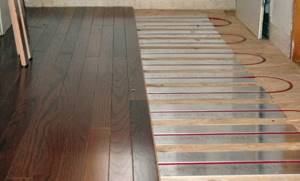
Is it possible to sleep on a heated floor?
Warm floors are used to maintain a comfortable temperature in the rooms. They are used for main room heating or for additional floor heating. Of course, the question arises: in what rooms are such structures installed? Is it possible to use heated floors in the bedroom? To get the answer, it’s worth studying all the pros and cons of such a solution.
There are two energy sources for heated floors: heated water and electricity. The latter option is more often used for local heating, and the first – for autonomous main heating.
Attention! Water floors are a budget option for heating a room.
Warm floors in the bedroom with liquid coolant are considered durable and less expensive, but problems may arise during installation and maintenance. The structure consists of a pump, pipes and a boiler. There are several ways to install it:
- concrete screed;
- wooden floor;
- laying the finished floor on aluminum sheets;
- self-leveling floor
The installation of an electric heated floor covering in the bedroom is carried out using a special cable and mats made of heating elements. The latest technologies include infrared floors, which are based on rods and films. This floor is used for additional heating. To install an electric heating system, you must comply with some safety requirements:

Electric floor installation diagram
- dry coating;
- installation of thermal relay;
- high-quality insulation and grounding.
Installation of the structure has the following nuances:
- To organize direct exposure, the warm floor is laid as close to the coating as possible.
- Cables and mats are thin, so they are used even in rooms with low ceilings.
- The system is capable of accumulating heat.
Attention! Cable heated floors have a long service life, if you choose the right floor covering - laminate is better suited.
Heating the floor covering in the bedroom using infrared floors involves the passage of electric current with the formation of electromagnetic radiation, which heats the finished floor. In this case, warm air moves across the entire area from bottom to top.
Structures made of mats and cables perform their functions only if the final floor covering is chosen correctly. For them, it is preferable to use laminate, and for film heated floors in the bedroom you can choose carpet, laminate, wood, or linoleum.
To understand whether it is possible to have a heated floor in the bedroom, it is worth knowing its positive and negative sides. The first include the following:
- A warm floor in the bedroom will forever eliminate damp corners and the development of fungi on the walls, as it eliminates the increase in humidity.
- It is impossible to get a burn from such a heating system, since the temperature on the surface is comfortable for walking barefoot - no more than 30 degrees.
- There is a self-regulation function using additional devices. They automatically control the temperature day and night.
- The installed heating system is invisible to outsiders; you can apply any design, which is limited only by your imagination.
- There are no drafts in the room.
- Savings on heating are up to 30%.
- It is easier to keep the room tidy and clean.
Disadvantages of underfloor heating:
- Comparatively expensive.
- Difficulty in installation, especially during ongoing repairs.
- Non-repairable.
- High requirements for the floor covering that is installed on the heating system - it must have a high thermal conductivity.
Many people worry that it is impossible to install heated floors in the bedroom, arguing that they are only suitable for utility rooms and places where people rarely visit. This statement is absolutely incorrect and most likely arose after using low-quality flooring, which emitted unpleasant odors when heated. Today, the market offers many good quality coatings that are environmentally friendly and do not emit harmful substances. Therefore, using heated floors in the bedroom is safe and cost-effective.
The second myth that circulates among consumers: floor heating is not used in the bedroom, since the heat coming from below (close to the head) is harmful to human sleep and health. After all, it is known that during sleep the room should be ventilated. The bedroom requires cool and fresh air. This is right. By the way, we can solve this issue with a heated floor system, since it has the ability to automatically regulate the temperature. Therefore, setting the desired value is easy.
Having studied how a heated floor is installed in a bedroom, the pros and cons of installing it, everyone makes their own choice. However, we should not forget about the large number of advantages and several disadvantages, which are offset by the comfortable conditions in the room.
Laying heated floors in the bedroom:
Warm floors in the bedroom are an excellent option to improve the temperature in the room in winter without unsightly radiators. But many are scared off by myths about this system and many incomprehensible terms. In fact, there is nothing complicated about a heated floor system, and all myths are relics of the past or the result of a misunderstanding of how the system works.
At the time the first prototypes of heated floors were used, the system was far from perfect, so it managed to acquire myths that are no longer relevant. The most popular myth is that the floor temperature is too high, which will “burn your heels.” In fact, this is impossible. Warm floors are a low-temperature system, so it is impossible to get burns or simply unpleasant sensations.
The second most popular myth is low thermal efficiency, due to which underfloor heating is only capable of heating the room to a comfortable temperature. This one is a little more complicated. When heated floors first began to appear, it was indeed a low-power system. Today, underfloor heating can be used to heat the entire house without any temperature problems. One of the reasons for the myth is the fact that underfloor heating is a low-temperature system. But she does not need high temperatures: this can cause overheating and burns of the legs, and too high a temperature in the room. There is no need for high coolant temperatures; a warm floor can provide and maintain a comfortable environment with low coolant temperatures.
The third myth says that heated floors spoil floor coverings such as laminate or parquet, and moreover, it cannot be laid under wood. All modern coatings can easily withstand the installation of heated floors. And a system with infrared film can be covered with chipboards instead of screed. In other cases, the tree can be laid on a concrete screed in which pipes or electrical cables are laid. Gone are the days when laminate flooring melted under the influence of low temperatures.
There are several types of heated floors today. The choice depends on the needs of each individual person and the characteristics of connecting to heat sources.

Water heated floor
Water-based floors require thick screeds and high costs during installation. For water pipes, the correct installation of the collector, a drawn diagram of the pipe “snake”, and the correct installation of this pipe are required. All this is associated with certain difficulties. In addition, in order to correctly delineate the places where the pipes will pass, you will have to contact a heating engineer.
But at the operating stage, a water floor is more economical than an electric one. The cost of heating water has always been less than the cost of electricity. The only disadvantage of using water heating systems is the failure of the collector. The collector needs to be changed every 5 years, since the old one quickly becomes clogged and corroded, which can lead to damage to the system as a whole.
Installing sensors and a thermostat can save even more money. So, using a timer, you can set the heating to warm up just before you come home from work, or warm up the floor more strongly before going to bed - everything is done not only to save money, but also for human comfort.
To connect a warm water floor in the bedroom, you need to configure the boiler correctly. You cannot heat the entire house with water at a temperature of 70 degrees and supply it to the heated floor. Warm floors are a low-temperature system; the coolant in it should not exceed 60 degrees.
Unfortunately, such a floor cannot be installed in an apartment. Due to the additional water consumption, the hydraulic mode of the building's heating system changes greatly. This can cause the system to become unbalanced, leading to the failure of individual radiators throughout the house. Therefore, not a single BTI will issue permission to install a water heated floor in an apartment. Or rather, not for installation, but for connecting this floor to the citywide central heating system.
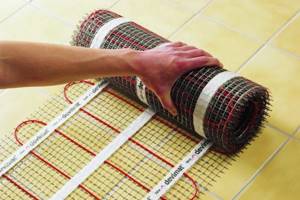
Electric heated floor
The electric floor was developed specifically for residential heating. This is a heating cable that is sold in two variations:
- In the form of a single cable, which is secured with staples or placed in the grooves of rubber plates
- In the form of a thin cable strung on a mesh base that simply rolls out across the floor
In the second case, installation is simpler: there is no need to draw a “snake” of the heated floor, just roll out the mesh, secure it with brackets and continue installing the floor. For electric heated floors there is no need for a thick screed. If a water floor makes the entire surface of the floor a heating device, then the cable itself is a heating device, so there is no need for a thick screed. The cable is not so susceptible to mechanical stress. All this, together with operation from a simple outlet, would make the electric floor a market leader, if not for the price of electricity. Special sensors and regulators can significantly reduce costs, but operating costs will still remain at a fairly high level.
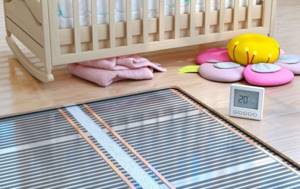
Infrared film floor
Infrared film is an intermediate model between water heated floors and electric ones in terms of costs. For installation, you do not need a screed at all; you can use ordinary chipboard slabs, which are then covered with laminate or any other covering. The principle of infrared film is to pass electricity through a thin aluminum film secured between two insulators. Due to the small cross-section of aluminum, electricity consumption and heat dissipation are reduced.
This option is considered the most successful, but it is not suitable for large rooms, since the likelihood of mechanical impact on the film through the thickness of the floor increases. And through a floor that is too thick, the heat simply will not reach the room.
The advantages of heated floors in the bedroom are obvious:
- More favorable temperature conditions in the room. A warm floor spreads heat using electromagnetic waves. Such heating has a beneficial effect on a person’s well-being and performance. Studies have shown that in a better temperature environment, it is easier for a person to fall asleep and sleep more pleasantly, which is especially important for the bedroom.
- Easy to use. Conventional radiators accumulate dust; this is largely due to convection, which heats the room. Air currents move dust throughout the room. Air does not participate in radiative heat exchange between the floor and surfaces in the bedroom, which means there will be less dust on high surfaces and in the air.
- Economical. Economy refers to system parameters. Warm floors are low-temperature heating, that is, less fuel is spent on heating the coolant, which means the system is more economical than conventional convective heating. As for the electric heated floor, it is more economical than an electric boiler of equivalent power.
Warm floors in the bedroom are an excellent opportunity to increase the comfort in the room and not worry about drafts. Installing a heated floor is no more difficult than conventional heating, but a heated floor is more economical. You should not believe the myths that surrounded this system at the beginning of its existence; rely only on your own preferences and real information.
